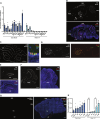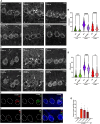RREB1 regulates neuronal proteostasis and the microtubule network
- PMID: 38198538
- PMCID: PMC10780896
- DOI: 10.1126/sciadv.adh3929
RREB1 regulates neuronal proteostasis and the microtubule network
Abstract
Transcription factors play vital roles in neuron development; however, little is known about the role of these proteins in maintaining neuronal homeostasis. Here, we show that the transcription factor RREB1 (Ras-responsive element-binding protein 1) is essential for neuron survival in the mammalian brain. A spontaneous mouse mutation causing loss of a nervous system-enriched Rreb1 transcript is associated with progressive loss of cerebellar Purkinje cells and ataxia. Analysis of chromatin immunoprecipitation and sequencing, along with RNA sequencing data revealed dysregulation of RREB1 targets associated with the microtubule cytoskeleton. In agreement with the known role of microtubules in dendritic development, dendritic complexity was disrupted in Rreb1-deficient neurons. Analysis of sequencing data also suggested that RREB1 plays a role in the endomembrane system. Mutant Purkinje cells had fewer numbers of autophagosomes and lysosomes and contained P62- and ubiquitin-positive inclusions. Together, these studies demonstrate that RREB1 functions to maintain the microtubule network and proteostasis in mammalian neurons.
Figures






Similar articles
-
The transcription factor Rreb1 regulates epithelial architecture, invasiveness, and vasculogenesis in early mouse embryos.Elife. 2021 Apr 30;10:e64811. doi: 10.7554/eLife.64811. Elife. 2021. PMID: 33929320 Free PMC article.
-
Mutations in the microtubule-associated protein 1A (Map1a) gene cause Purkinje cell degeneration.J Neurosci. 2015 Mar 18;35(11):4587-98. doi: 10.1523/JNEUROSCI.2757-14.2015. J Neurosci. 2015. PMID: 25788676 Free PMC article.
-
Loss of RREB1 in pancreatic beta cells reduces cellular insulin content and affects endocrine cell gene expression.Diabetologia. 2023 Apr;66(4):674-694. doi: 10.1007/s00125-022-05856-6. Epub 2023 Jan 12. Diabetologia. 2023. PMID: 36633628 Free PMC article.
-
Transcription Factor RREB1: from Target Genes towards Biological Functions.Int J Biol Sci. 2020 Feb 21;16(8):1463-1473. doi: 10.7150/ijbs.40834. eCollection 2020. Int J Biol Sci. 2020. PMID: 32210733 Free PMC article. Review.
-
Homeostatic Roles of the Proteostasis Network in Dendrites.Front Cell Neurosci. 2020 Aug 14;14:264. doi: 10.3389/fncel.2020.00264. eCollection 2020. Front Cell Neurosci. 2020. PMID: 33013325 Free PMC article. Review.
Cited by
-
Neocortical tau propagation is a mediator of clinical heterogeneity in Alzheimer's disease.Mol Psychiatry. 2025 Sep;30(9):4194-4213. doi: 10.1038/s41380-025-02998-y. Epub 2025 Apr 16. Mol Psychiatry. 2025. PMID: 40234685
-
Cell-type-specific expression of tRNAs in the brain regulates cellular homeostasis.Neuron. 2024 May 1;112(9):1397-1415.e6. doi: 10.1016/j.neuron.2024.01.028. Epub 2024 Feb 19. Neuron. 2024. PMID: 38377989 Free PMC article.
-
Identification of hsa_circ_0018905 as a New Potential Biomarker for Multiple Sclerosis.Cells. 2024 Oct 9;13(19):1668. doi: 10.3390/cells13191668. Cells. 2024. PMID: 39404430 Free PMC article.
-
Distribution and functional significance of KLF15 in mouse cerebellum.Mol Brain. 2025 Jan 21;18(1):3. doi: 10.1186/s13041-025-01172-3. Mol Brain. 2025. PMID: 39838470 Free PMC article.
References
-
- Gu Z., Cao H., Zuo C., Huang Y., Miao J., Song Y., Yang Y., Zhu L., Wang F., TFEB in Alzheimer’s disease: From molecular mechanisms to therapeutic implications. Neurobiol. Dis. 173, 105855 (2022). - PubMed
Publication types
MeSH terms
Substances
Grants and funding
LinkOut - more resources
Full Text Sources
Molecular Biology Databases
Research Materials

